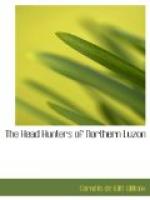CHAPTER VII
School at Campote.—Our
white pony, and the offer made for
his tail.
It was too dark by this time to see or do much. We had supper, looked up the place where we were to sleep, and then collected at the lower of the two shacks. Here we received visits, so to say, from as many Ilongots, grown men only, as could get into the place. In truth, we were as much objects of curiosity to them as they possibly could have been to us. To Mr. Worcester the occasion was one of business, explaining through interpreters why we had come, what the Government wanted, getting acquainted with the cabecillas (head men), and listening to what they had themselves to say. One of our visitors was a grandfather, remarkable, first, because of his heavy long beard, and, second, because his own grandfather was alive; five generations of one family in existence at the same time.
Campote, I may as well say it here as anywhere else, is merely a point where Connor has established a school for children, under a Christianized Filipino teacher. Some thirty children in all are under instruction, the average attendance being twenty-four. It is almost impossible, so Connor told us, to make these people understand why children should go to school, or what a school is, or is for, anyway. However, a beginning has been made. They all have a dose of “the three Rs”; the boys are taught, besides, carpentry, gardening, and rope-making, and the girls sewing, weaving, and thread-making from cotton grown by the boys on the spot. They ought to show some skill in all these arts; for the native rice-basket is a handsome, strong affair, square of cross-section, with sides flaring out, and about three feet high, and some of their weapons show great manual skill. The garden was on show the next morning, displaying beans, tomatoes, cotton, perhaps other things that I failed to recognize or have forgotten, anyway, a sufficient garden. There is besides an exchange here for the sale of native wares.
One of our party had ridden a white pony, and was much amused, as were all of us, to receive an offer for his tail! There is nothing else the Ilongots hold in higher estimation than white horse-hair, and here was a pony with a tail full of it! But the offer was refused; the idea of cutting off the tail was not to be entertained for one moment. Certainly, he might keep its tail: what they wanted was the hair. Would he sell the hair? No; that was only a little less bad than to sell the tail itself.




